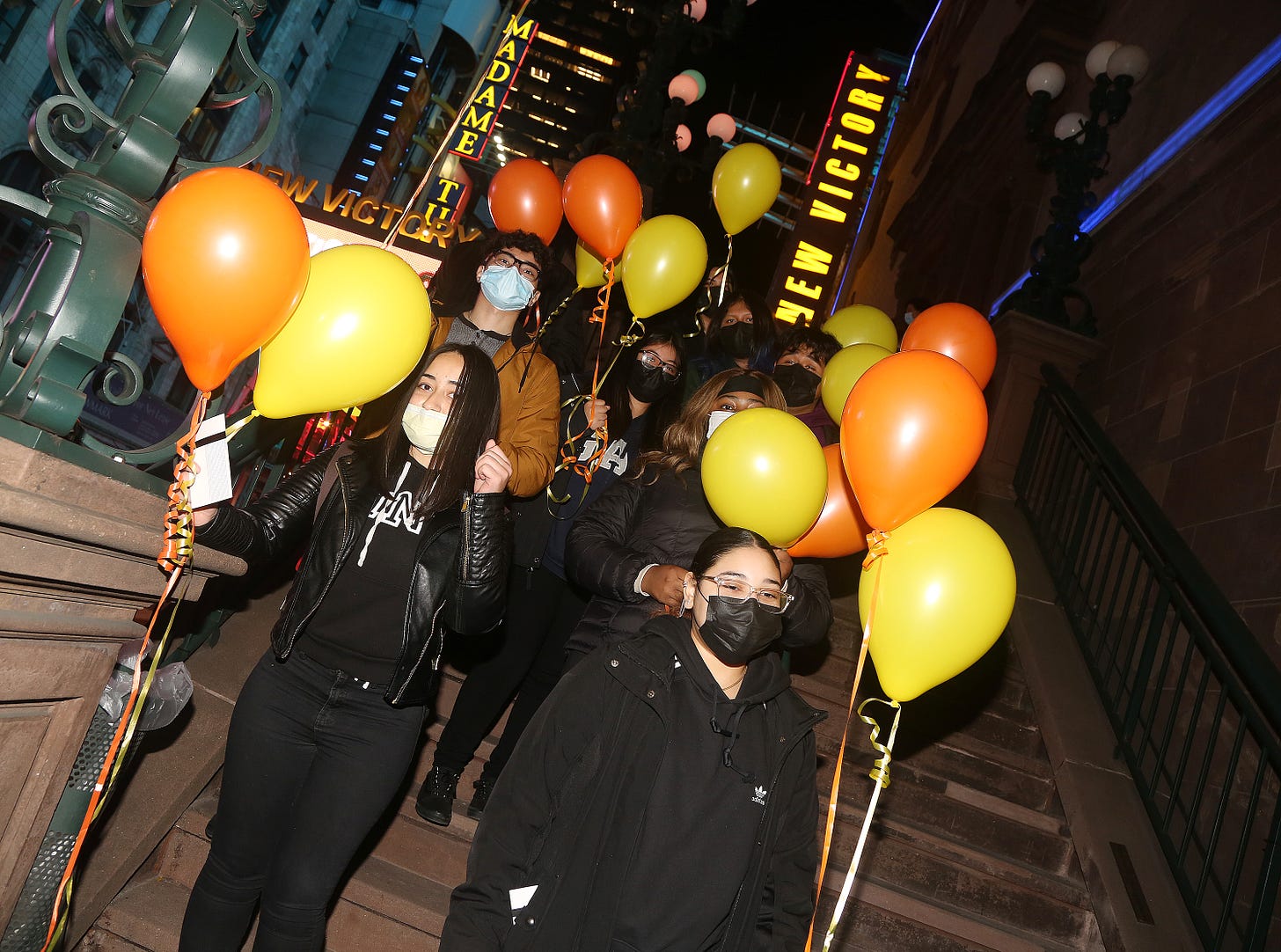Last month, we brought you John Sailer’s investigation into how diversity, equity, and inclusion (DEI) initiatives are supplanting the core mission of our nation’s universities—putting social justice ahead of the search for the truth. Today, The Free Press brings you our second story in this series, showing how these same DEI demands are transforming fine arts institutions and foundations across the country.
The trouble began for Lincoln Jones, as it did for so many in the summer of 2020, with the black square.
Jones, 47, is a longtime and celebrated Los Angeles–based choreographer. For 11 years he has run the American Contemporary Ballet company. His work has been featured regularly in The New York Times and Los Angeles Magazine, which called his 2012 ballet Serenade in A “a multifaceted snapshot of beautiful choreography crisply integrated with music.”
By any measure, his career has been hugely successful.
But Jones noticed things starting to change after May 2020, when George Floyd was murdered by Minnesota police. “All of a sudden, it felt like you had to make your practices, discussion, everything, not only about race but about diversity, equity, and inclusion.”
He became increasingly unsettled by what he saw as coercive demands on speech and behavior. “I specifically don’t make art political, but the arts were becoming a tool of an ideology,” Jones, who is white, recalled. “It felt like something sacred was being violated by crossing politics and art—almost like crossing church and state.”
Suddenly, in the summer of 2020, questions swirled over whether his company ought to post the black square, which signified support for Black Lives Matter, on their company’s official Instagram.
“Our dancers were free to post whatever they wanted on their own social media, but I knew I wasn’t going to do it on the company account,” he said. “That’s not part of our mission.”
But backlash erupted on social media from both acquaintances and strangers. One Instagram message from a former employee stated, “Art is inherently political so your messaging seems to be spiteful of a crucial movement.” A former dancer from Jones’s company posted a message on their Instagram Story: “If this doesn’t drip with cowardice and blind misunderstanding of privilege and accountability to your community, I don’t know what does.”
Meanwhile, some of Jones’s dancers started questioning his refusal to post the symbol after they, too, became the target of social media backlash.
In the face of mounting pressure from the dance world, Jones sent an email to his employees clarifying his position. “American Contemporary Ballet is not a political organization,” he wrote. “Our mission is great dance. It is not our prerogative to represent each other politically.”
That’s when his work started to take a hit. His plans to turn his company’s adaptation of The Nutcracker into a film fell through, even though his proposal was under consideration by “some of the most renowned directors in Hollywood,” he said.
When an agent he hired to find funding and get a director for the project told him he needed to hire dancers of color from outside his company to get the film made, Jones objected.
“One of the things I will not do is hire by race or give preference by race,” he said. “Ballet does discriminate, just not by race. This is a highly athletic art form that discriminates by body, talent, and artistic sensitivity. You have to have a certain kind of feet and proportions. It’s not just a convention. It’s like an opera singer having a loud voice.”
So Jones pushed back against the agent’s advice. “I told him I don’t hire by race, and he said, ‘If you say that, you’ll never work again.’”

Meanwhile, Jones said he faced an uphill battle for funding, as many grant-giving institutions started to insist that applicants abide by new diversity requirements. Even as far back as 2018, the Los Angeles County Department of Arts and Culture demanded all applicants for Organizational Grant Programs submit “board-adopted statements, policies or plans that outline their commitment to diversity, equity, inclusion and access.”
And now others were following suit.
Jones said several funders told him they were no longer going to support the American Contemporary Ballet—a devastating blow for the company, which depends heavily on outside largesse to keep afloat.
Other lines of funding, Jones recalled, “just disappeared.”
“Fundraising felt impossible,” he added. “The requirement on grants comes down to this: If you don’t agree with this very particular and recently adopted approach to social justice, we won’t fund your art. Behind the scenes, so many people in the arts world told me just to say the words.”
“Every time I spoke to funders, the first conversation was about diversity. It just felt like, okay, this is how you get funding now. Honestly, it felt like somebody was holding a gun to my head and saying, ‘Your integrity or your life’s work.’”
That bargain—pledge allegiance to the new orthodoxy or stick to your mission and risk your career—is one now faced by many in the world of American fine arts.
I spoke to more than a dozen people working in dance, music, theater, and the visual arts. Some have won Pulitzer prizes. Others are just at the beginning of their careers. What they all have in common is a concern that DEI—short for diversity, equity, and inclusion, a catchall term for racial equity initiatives—is creeping into the arts and politicizing artistic expression.
But only a tiny number of those people have blown the whistle.
Kevin Ray is one of them. Ray, who is white, is a theater director with 25 years of experience in the industry. In 2014, he took a part-time gig offering educational outreach for New 42, a performing arts nonprofit in Manhattan. Among its work, New 42 operates New Victory Theater, which offers a program giving stipends directly to artists and requires that every applying artist “identify as Black, Indigenous or a Person of Color.”
In June 2022, Ray sued New 42, claiming the institution forced him and other employees to take DEI instruction and read “racially-discriminatory propaganda.”
He said staffers were sent a document called “White Supremacy Culture—Still Here” by Tema Okun, asserting that whiteness divides “each and all of us from the earth, the sun, the wind, the water, the stars, the animals that roam the earth.”
The suit says staff members were given a link to Okun’s website, which claims that individualism, perfectionism, objectivity, denial, defensiveness, and power-hoarding are characteristics of white supremacy culture.
In his legal complaint, Ray said he was segregated by skin color at workplace meetings because, according to material circulated by the company to staff, “mixed-race dialogues are often inappropriate for White people” and “placing White folks in interracial dialogue is like placing pre-algebra students in a calculus class.”
“White people,” it stated, “need something akin to a remedial course.”

The lawsuit is still pending, but in a recent filing, lawyers for New 42 argued that Ray “suffered no damage” and denied that New 42 ever acted in a “malicious manner,” adding that “the alleged conduct... [was] not objectively severe or pervasive to support a hostile work environment claim,” and Ray “was not treated less well because of his race.” David Lichtenberg, who represents New 42, told The Free Press he was not authorized to comment. A representative of New 42 also declined to comment.
But Ray’s case is not an isolated one.
Following the death of George Floyd, a petition drafted by black actors and playwrights called “We See You, White American Theater” was circulated, dubbing the theater community “a house of cards built on white fragility and supremacy.” The petition garnered more than 100,000 signatures, including those of acclaimed black playwrights Lynn Nottage and Dominique Morisseau.
Accompanying the letter is a 31-page list of demands for theaters, urging them to implement quotas that result in the “majority of writers, directors, and designers on stage for the foreseeable future [being] BIPOC”—an acronym for black and indigenous people of color—and establish “exclusive affinity spaces for the protection of BIPOC bodies inside of all institutions.”
The ripples of revolution trickled all the way up to Broadway. In November 2022, Keith Wann, a sign language interpreter who worked on a production of The Lion King, alleged that he was removed from the production because he is white.
Wann sued the nonprofit Theater Development Fund, which connects Broadway shows with sign language interpreters, after the group said it was “no longer appropriate to have white interpreters represent black characters for [American Sign Language] Broadway shows.” He also claimed the fund’s director asked him to “back out” of the show because he is “not a black person and therefore should not be representing Lion King.”
The lawsuit was settled in just two weeks. Wann, who is the child of deaf parents, declined to comment on the terms of the settlement, but said of his complaint: “My stance was, you can’t say this. You can’t say, ‘Hey, because you’re deaf we’re getting rid of you, or because you’re old we’re getting rid of you, or because you’re an amputee we’re getting rid of you.’ It was wrong.”
Wann, 54, said that after interpreting around twenty Broadway plays, he’s given up on the Great White Way. “I’m at the end of my career. I’m not going to pursue this anymore. I’m not going to fight that fight.”
David LeShay, Director of Marketing and Public Relations at the Theater Development Fund, told The Free Press, “The matter between Keith Wann and TDF has been settled to the satisfaction of both parties. We will have no further comment.”

Any theater attempting to implement DEI demands could find itself at the other end of a lawsuit, said civil rights lawyer Michael Thad Allen of Allen Harris Law, who is representing Ray in his suit.
“Many people have the misconception that anti-discrimination laws only apply to historically disadvantaged communities,” Allen said. “I think these civil rights cases are pretty straightforward: Don’t discriminate on the basis of race.”
“There’s nothing wrong” with signing a petition saying you want a majority of staff to be BIPOC, Allen said. “That’s perfectly acceptable.”
But Title VII federal law—part of the Civil Rights Act of 1964 prohibiting employment discrimination based on race, color, religion, sex, and national origin—means hiring people purely on the basis of race could be deemed “a potential violation,” he said.
“It would be different if you were a private foundation,” he added, because they are “permitted to promote their private agenda.” But organizations that receive federal funding (like New 42, according to Ray’s suit) “are not allowed to discriminate on the basis of race.”
Even some artists who are far in their career are too scared to comment about the new DEI demands.
“Artists already have enough challenges, and now we have all these layers of bureaucracy and mandates,” said one Pulitzer Prize–winning creative, who asked me not to print his name or even his field because he fears reprisals. “Artists are just too vulnerable to the vagaries of funding and cultural trends. Even those who are successful just can’t risk it. A freelance artist’s career could be over tomorrow if they make a fuss.”
He said he worries about America’s new generation of artists. “I’m established. I’m far enough along in my career that it doesn’t affect me as much as it does artists in [the younger] generation.”
Brent Morden is one of them. Morden is a white, 25-year-old music and choir director in New York City. Though he’s only at the beginning of his career, he said he’s already felt the crunch of funding and lost opportunities because he doesn’t tick any diversity boxes.
“When I see commissions or opportunities that are specifically looking for females or LGBTQ or BIPOC people to apply, I just sigh, wonder what this achieves, and move on,” he said. “Artistic institutions are adopting mission statements that sound nice and virtuous, but if you dig deeper under the surface, they’re promoting an agenda that doesn’t promote true and fair diversity, equity, and inclusion.”
His feelings are echoed by renowned Broadway theater producer Rocco Landesman. From 2009 to 2012, Landesman served as the chairman of the National Endowment for the Arts under the Obama administration. He told me he started noticing DEI creeping into the arts world around 2013 and has “no doubt” that “we’re seeing increasingly coercive guidelines.”
Landesman said he was shocked when, in 2019, a San Francisco school board voted to paint over a mural at George Washington High School that depicted the life of America’s first president, because it was deemed offensive to black and Native Americans.
“When you have art actually being destroyed because it doesn’t fit into a certain view of the world, that’s extremely alarming,” Landesman said.
Though the board reversed its decision last year, the controversy shows how the left has turned its back on the arts in the name of pursuing diversity, Landesman said.
“It’s shocking to see that proposed by progressives. I never thought we’d come to that point—it’s an amazing turn to see liberals be literally anti-art.”

Today, many of America’s arts funders have made social justice the criteria for grants. Of the two dozen foundations I surveyed that are based in New York and California and fund the arts, fifteen either professed allegiance to DEI principles on their websites or explicitly stated they strive for racial equity via philanthropic endeavors. Of the handful of actual grant applications I could get my hands on, several required DEI statements or demographic data from applicants.
The S. Mark Taper Foundation, for instance, which doles out roughly $6 million in grants a year focused on arts, education, and social causes, has committed itself to “a continuing examination of privilege” ensuring “grantmaking that aligns with the values of diversity, equity and inclusion.” As part of their application, each organization must provide a list of their board members’ titles, length of service, and racial and ethnic profiles.
And the Ford Foundation, one of the most influential charitable organizations in the country, boasting a $16 billion endowment, has led a group of fifteen major donors in dedicating $160 million specifically to BIPOC arts organizations.
Now, DEI initiatives for the arts are spreading at the national level. On September 30, President Biden signed his Executive Order on Promoting the Arts, the Humanities, and the Museum and Library Services, with the goal of advancing “the cause of equity” through “[f]ederal support for the arts.” The administration’s policies sparked the National Endowment for the Arts’ Equity Action Plan as well as its establishment of a Racial Equity and Access Working Group.
Two and a half years after the black square controversy, Jones said he is still trying to keep the American Contemporary Ballet afloat without giving in to DEI demands.
“We were financially strangled,” he said. “I tried to keep the dancers out of it, but I think most people thought we weren’t going to make it. I just hung on by my fingernails, but we’re still in financial danger.”
Landesman, 75, who has produced multiple Tony-winning shows including Angels in America and The Producers, said he worries about what is happening to the world where he has dedicated his entire life and career.
“We’re taking first-rate artists and making them into third-rate political activists,” he said.
“Art is supposed to unsettle us; art challenges what we feel about ourselves,” he continued. “But most of the art today affirms commonly held views of our society. You either fit in or you perish.”
This is Rikki Schlott’s first piece for The Free Press. Follow her on Twitter at @RIKKISCHLOTT.
The Free Press prides itself on spotlighting issues that other media outlets ignore, such as Rupa Subramanya’s recent piece on Canada’s assisted suicide program.
If you believe in our mission, become a subscriber today:











our Comments
Use common sense here: disagree, debate, but don't be a .